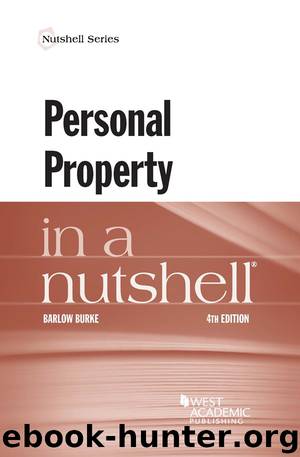Personal Property in a Nutshell by Barlow Burke

Author:Barlow Burke
Language: eng
Format: epub
ISBN: 9781634603379
Publisher: West Academic
Published: 2018-03-15T00:00:00+00:00
1.The Right to Sue and the Causes of Action
For centuries, common law judges debated whether or not a bailor could maintain an action against a person who wrongfully took a bailed chattel from a bailee. So long as the essence of the action against the trespasser was criminal in nature, or sounded in tort, the crime or the tort was committed against the bailee and on this basis the courts held that he alone had the remedy. Likewise, the bailee had the present right to possession, and his duty to deliver the chattel out of the bailment constitutes an interest in the chattel on which to ground his suit. Finally, however, the common law rule came to be that both bailor and bailee could maintain trespass.
191
Often the bailee is said to have a cause of action against convertors of the property because he is liable over to the bailor. This notion was given the lie in the case of The Winkfield, P. 42 (C.A. 1901), where the bailee was the English postal system and was not liable to its bailors, the persons posting letters. Nonetheless, the court decided that the bailee could maintain suit against a ship, The Winkfield, which negligently collided with another ship that carried the mail and sent the mail-boat to the bottom of the sea. So the bailee was suing a third-party tortfeasor that negligently interfered with the bailment. The court held that the bailee’s possession is good as against a wrongdoer, and that the latter would not have the defense of jus tertii.
The history of bailments shows two things: that the bailee has a right to sue where he is liable over, and that he is liable over because he has the right to sue. Which one of these rules has priority in the law, is now difficult to say. Where the bailee is strictly liable, he arguably should be the one with the right to control the suit against the tortfeasor, trespasser, or convertor of the chattel. When as today he is liable only if negligent, and even then has often limited his liability by contract, this right should be shared—and today both bailor and bailee have the right to sue on the theory that the one to do so will be the more diligent pursuer of the remedy. Today, in an age in which strict liability has fallen away from the bailee and a bailor’s suit against a bailee depends upon the proof of facts and the circumstances of the case, the bailor might as easily run the risks of litigation against the third-party 192
wrongdoer. At the same time, to deny the bailee a right to sue would deny this right to a party who often will have the best access to the facts of the case. The careful conclusion is that today both bailor and bailee should have the right to sue, together or separately, but that only one judgment per incident can be obtained between them.
The cause of action for the recovery of the value of a bailed chattel is trover.
Download
This site does not store any files on its server. We only index and link to content provided by other sites. Please contact the content providers to delete copyright contents if any and email us, we'll remove relevant links or contents immediately.
Property and Freedom (Vintage) by Richard Pipes(652)
P by Unknown(574)
Successful Property Letting: How to Make Money in Buy-to-Let by David Lawrenson(488)
Theft Is Property! (Radical Américas) by Robert Nichols(454)
Personal Property in a Nutshell by Barlow Burke(352)
